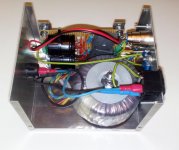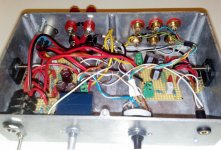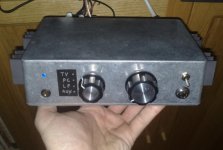Hi!
I just finished my lm3886 based stereo amplifier! I'm not new to DIY-electronics, but this is my first hifi-project and the first including a diy-power supply. The purpose of the amp is to drive a pair of bookshelf speakers (CSS FR125SR, also DIY), so the need for power isn't that huge. I run the amp with no preamp i between. It had to be small in order to fit where I wanted it, and I wanted a nice retro look. Total cost for this project was around 200 EUR. I'm also happy to note that this project needed zero debugging, everything worked "plug 'n play", yey!
Power supply:
I built an external PSU in order to keep the amp unit as small as possible. Toroidal 160VA +/-18V, circuitry from http://diyaudioprojects.com/Chip/LM3886_CA/F02-LM3886-power-supply.png . It measures +/- 26.0 VDC on my multimeter. I know some people say that 160VA is too small, but it's plenty for my needs and easy to upgrade should I want to drive bigger speakers someday. I use a mains cable with XLR-connectors as umbilical (Thanks to Redshift187 and AndrewT for helpful comments!)
Amplifier:
The circuit is basically the "Typical Application" of the lm3886 datasheet, with an added input capacitor (2.2uF) and dual (0.1uF/100uF) bypass capacitors. I used veroboard since that's what I'm used to. I've added a headphone jack (DPDT-switch, circuit from http://diyaudioprojects.com/Chip/DI...mplifier/TDA2050-Chip-Amplifier-Schematic.png ) and a 3 pole 4 way switch as source selector. The inputs are tree RCA and one 3.5mm stereo jack for iPod or such. I also added a blue led (75k resistor, I wanted it pretty dim).
The heatsinks are rather small, but the thick Hammond chassis is in itself a pretty good heatsink. The heatsinks and chassis only get slightly warm even when driven hard.
Review:
One of the main reasons for building this amp was that my 80's consumer grade Fisher amp has a hum and tends to boost the lows. It's also too big and has too many unnecessary features. My new amp solved these problems! It's really quiet, even with headphones and vol turned to max, you don't know even if the power is on or not. This is of course not the case when you plug in the crappy computer soundcard and my noisy RIAA-preamp (I'll have to rebuild this...), but that's another story. I tried to pay attention to connections and grounding, and apparently this paid off. The amp is small, and in my opinion, good looking.
The flat frequency response was a surprise at first, since I'm used to the boomy bass of the Fisher, but the LM3886-amp does apparently not flatten the lows even though it seemed like that at first. I tested without feedback and input caps - no audible difference, I also permanently changed the input cap from 1uF to 2.2uF for good measure (don't know if this really makes any difference). I guess the lack of bass response was just "mental pollution" from my old amp. I am not a hi-fi expert and my ears aren't trained in this respect, so I can't really comment on the sound, apart from that it sounds very good to my ears.
The only problem I've found so far is slight cross-talk between inputs. It might be the rotary switch or the cat.5-cable i use for input signal, but it's too small a problem to justify any major redesigns.
Thanks to all on this forum for great info, comments and questions are welcome!
I just finished my lm3886 based stereo amplifier! I'm not new to DIY-electronics, but this is my first hifi-project and the first including a diy-power supply. The purpose of the amp is to drive a pair of bookshelf speakers (CSS FR125SR, also DIY), so the need for power isn't that huge. I run the amp with no preamp i between. It had to be small in order to fit where I wanted it, and I wanted a nice retro look. Total cost for this project was around 200 EUR. I'm also happy to note that this project needed zero debugging, everything worked "plug 'n play", yey!
Power supply:
I built an external PSU in order to keep the amp unit as small as possible. Toroidal 160VA +/-18V, circuitry from http://diyaudioprojects.com/Chip/LM3886_CA/F02-LM3886-power-supply.png . It measures +/- 26.0 VDC on my multimeter. I know some people say that 160VA is too small, but it's plenty for my needs and easy to upgrade should I want to drive bigger speakers someday. I use a mains cable with XLR-connectors as umbilical (Thanks to Redshift187 and AndrewT for helpful comments!)
Amplifier:
The circuit is basically the "Typical Application" of the lm3886 datasheet, with an added input capacitor (2.2uF) and dual (0.1uF/100uF) bypass capacitors. I used veroboard since that's what I'm used to. I've added a headphone jack (DPDT-switch, circuit from http://diyaudioprojects.com/Chip/DI...mplifier/TDA2050-Chip-Amplifier-Schematic.png ) and a 3 pole 4 way switch as source selector. The inputs are tree RCA and one 3.5mm stereo jack for iPod or such. I also added a blue led (75k resistor, I wanted it pretty dim).
The heatsinks are rather small, but the thick Hammond chassis is in itself a pretty good heatsink. The heatsinks and chassis only get slightly warm even when driven hard.
Review:
One of the main reasons for building this amp was that my 80's consumer grade Fisher amp has a hum and tends to boost the lows. It's also too big and has too many unnecessary features. My new amp solved these problems! It's really quiet, even with headphones and vol turned to max, you don't know even if the power is on or not. This is of course not the case when you plug in the crappy computer soundcard and my noisy RIAA-preamp (I'll have to rebuild this...), but that's another story. I tried to pay attention to connections and grounding, and apparently this paid off. The amp is small, and in my opinion, good looking.
The flat frequency response was a surprise at first, since I'm used to the boomy bass of the Fisher, but the LM3886-amp does apparently not flatten the lows even though it seemed like that at first. I tested without feedback and input caps - no audible difference, I also permanently changed the input cap from 1uF to 2.2uF for good measure (don't know if this really makes any difference). I guess the lack of bass response was just "mental pollution" from my old amp. I am not a hi-fi expert and my ears aren't trained in this respect, so I can't really comment on the sound, apart from that it sounds very good to my ears.
The only problem I've found so far is slight cross-talk between inputs. It might be the rotary switch or the cat.5-cable i use for input signal, but it's too small a problem to justify any major redesigns.
Thanks to all on this forum for great info, comments and questions are welcome!
Attachments
Bigger speakers are generally more efficient and/or give more extended bass response.Power supply: Toroidal 160VA +/-18V, ................................ It measures +/- 26.0 VDC on my multimeter. I know some people say that 160VA is too small, but it's plenty for my needs and easy to upgrade should I want to drive bigger speakers someday
If you do go for bigger speakers you may find you can do with less power than you use at present.
Speaker designers balance size + efficiency + bass extension to give an overall performance.
You can usually get any two from these three. No amount of compromise nor design ingenuity can ever get all three.
Thanks, good point!
Right you are. You can't have everything if you want your speakers to fit into a bookshelf. (The speakers in question: http://www.diyaudio.com/forums/full...ge-speaker-photo-gallery-135.html#post2343112 )
Speaker designers balance size + efficiency + bass extension to give an overall performance.
You can usually get any two from these three. No amount of compromise nor design ingenuity can ever get all three.
Right you are. You can't have everything if you want your speakers to fit into a bookshelf. (The speakers in question: http://www.diyaudio.com/forums/full...ge-speaker-photo-gallery-135.html#post2343112 )
- Status
- Not open for further replies.


